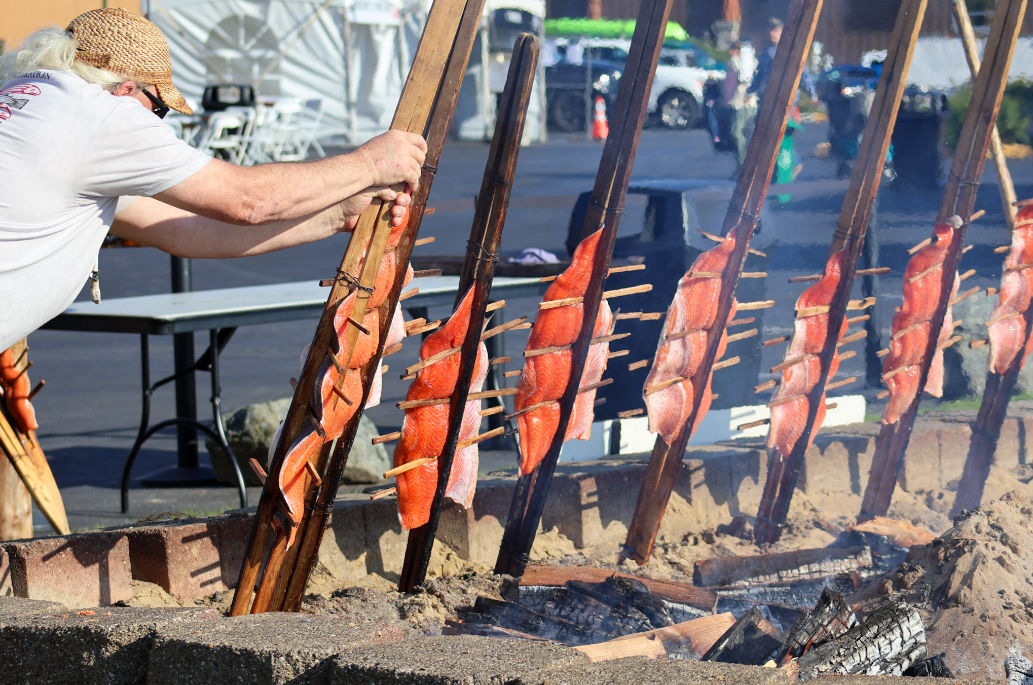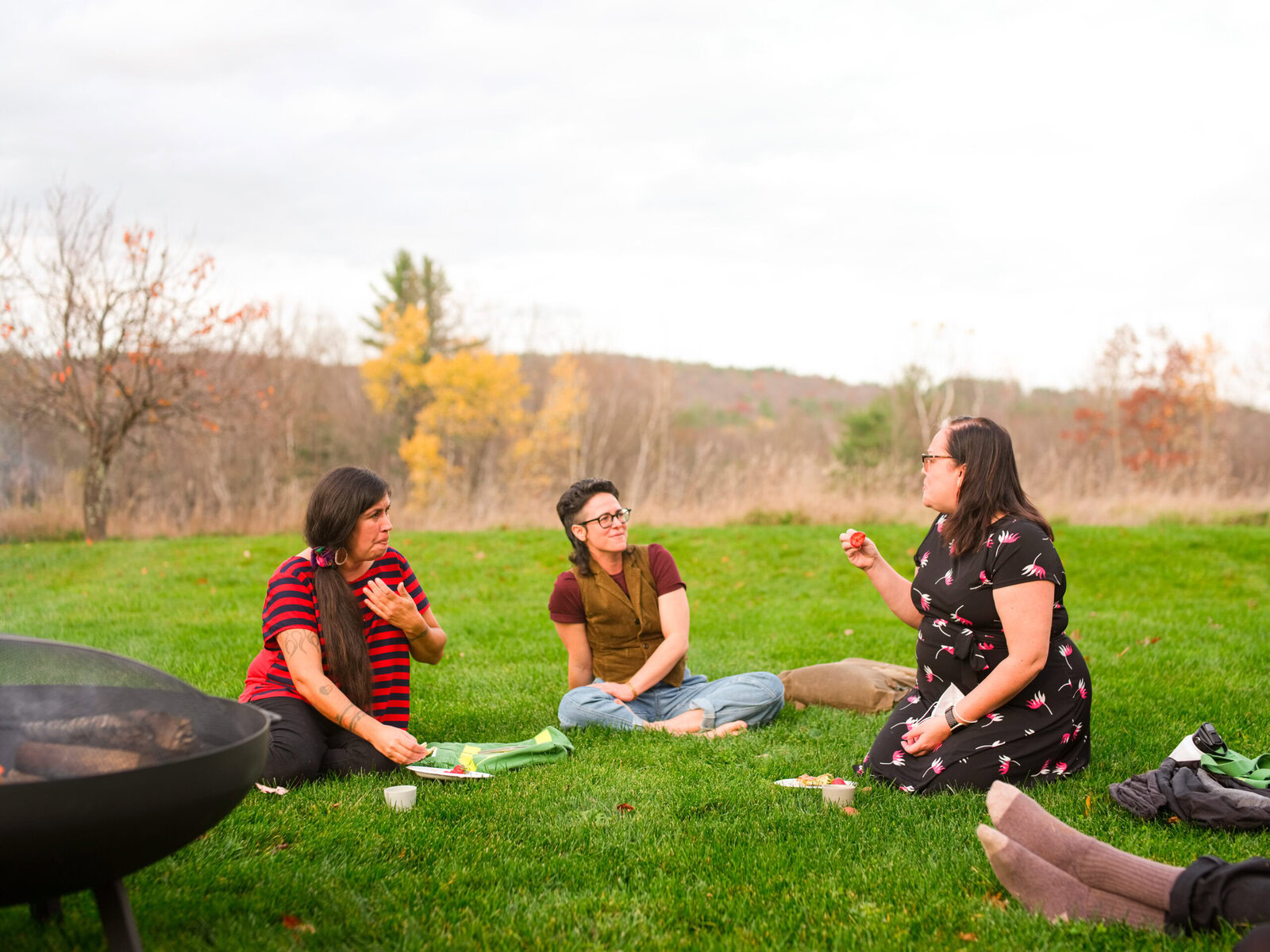When visitors take a tour of Forge Project, a nonprofit in the Mahicannituck (the Mohican name for what is now known as the Hudson River) Valley, they encounter two buildings designed by the artist Ai Weiwei, which host half a dozen Native fellows every year. They see works by Native artists, part of a lending collection of more than 175 pieces the organization stewards. They take in the view of a meadow where native plants are thriving, a part of Forge’s land remediation program.
Half of the fees visitors pay for these tours goes to the Stockbridge-Munsee Community band of Mohican Indians on whose homeland Forge Project sits.
The biweekly public tours are only one small element of the multi-faceted work of this Native-led social justice organization focused on fostering Indigenous leadership in culture and art. And the sharing of these profits is part of a much broader approach that prioritizes practices of reciprocity.
Cultures of reciprocity and sharing are central to many Native communities. These practices can infuse communities in a multitude of ways, from personal relationships to interactions with nature to the operations of tribal governments. At Forge and in other contexts, various traditions of reciprocity are supporting social justice and countering long-term harm to Indigenous people.
At Forge, the goal is not only to make a practice of redistribution of wealth, but to encourage others to do so as well. “How do we recreate that culture where there’s the deep understanding that the redistribution of wealth is a part of reciprocity, but it actually will enable the well-being of all of us, not just some of us?” asks Candice Hopkins, executive director and chief curator of Forge Project, and a citizen of the Carcross/Tagish First Nation.
“This culture of reciprocity is still something that is not only valued but expected in many, many Native communities,” says Hopkins. “It’s one of our foundational values.”
Just as there are many diverse Native cultures, there are many different practices of sharing and gifting. For instance, among the Carcross/Tagish First Nation, of which Hopkins is a citizen, reciprocity is central to social life.
The Carcross/Tagish First Nation, Hopkins says, is “essentially a potlatch people, which means that you gain your rank and your standing in your community by how well you can host, by how hospitable you are.”
Across different Indigenous groups, a wide range of practices falls under the label of “potlatch.” Even the overarching concept of “potlatch” reflects categorization by non-Native people: Specific traditions around gifting and reciprocity vary between communities and nations. But in some cases, descriptions by non-Native researchers and government policies grouped them together.
Over centuries, these practices have been suppressed by colonial governments. In Canada, for instance, a federal law banned potlatch from 1885 to 1951, criminalizing gifting ceremonies common in tribes of the Pacific Northwest Coast. The policy also stifled cultural activities among Indigenous communities more broadly.
Today, cultures of reciprocity are central among many Indigenous communities, including among the Coquille Indian Tribe, in Southwest Oregon, whose members say that the custom of potlatch is evident in almost every aspect of life.
On a sunny day in June, at a gathering near the waterfront in Bandon, Oregon, members of the Coquille Indian Tribe served salmon slow cooked over a fire and fry bread with huckleberry butter to anyone who joined. Guests left with handmade necklaces and earrings.
The event celebrated the 35th anniversary of the federal law that restored recognition of the tribe as a sovereign Indian Nation by the US government, a landmark recognition for the Coquille. Congress had terminated the government’s trust relationship with the tribe three and a half decades earlier.
Weighed down by negative news?
Our smart, bright, weekly newsletter is the uplift you’ve been looking for.
This waterfront celebration with the general public was, for Jackie Chambers, secretary treasurer on the Tribal Council of the Coquille Indian Tribe, more than just a shared meal. It was an example of the tribe’s tradition of sharing.
“I feel like we practice potlatch in everything that we do as a Coquille people, whether it be while we’re out hunting, while we’re gathering, when we host events,” Chambers says. “We’re so immersed in it, and it is just something that has been part of our lives since our people first came to this land.”
That includes the activities of the Tribal Council, the Coquille Indian Tribe’s governing body, whether in managing natural resources or public health. When the tribe opened two wellness centers, it aimed to offer health care in a setting where patients would feel comfortable and welcomed.

“It’s not always like giving a gift or you’re receiving something tangible,” says Chambers. “To me, it also can just be the type of care that you receive.”
Sharing practices are also evident in the Coquille Tribal Community Fund. Established in 2001, the initiative distributes some of the proceeds from the tribe’s Mill Casino to initiatives around the region. To date, the fund has given out about $8.7 million, supporting causes ranging from addressing food insecurity to replacing equipment for local fire departments. The fund also contributed to the construction of a new building for health science and tech studies at a local community college.
Since these resources are being shared across this region of southwest Oregon, members of the tribe and neighbors all see benefits. The new fire equipment helps keep homes safe. The community college trains health care workers, some of whom go on to work locally.
“When our communities around us are happy and healthy, in turn, we are too, and vice versa,” Chambers says.
While cultural practices of reciprocity are central within many Native cultures, they are also helping to shift long-held institutional practices that have been harmful to Indigenous people.
At Forge Project, one area where this ethos comes through is in its lending collection of Native art.
For generations, museums have failed to invest in Native art, explains Hopkins. With its collection, which has loaned works to 40 institutions and exhibitions worldwide, Forge is encouraging cultural institutions to question that lack of representation.
Forge is also changing how lending agreements work, according to Hopkins. The organization makes sure that protocols set out by the artist for each work are followed — for instance, some pieces must be stored covered with a white cloth, and welcomed into an exhibition space. Forge also seeks consent from artists before works go to certain settings, and agreements with institutions stipulate details like use of images of art and the creation of merchandise.
Through this approach, Forge is seeking to make interactions around art less transactional and more reciprocal.
“This is our way of showing how there’s new ways to operate in the world,” Hopkins says. “We don’t have to accept, in some ways, those practices that we’ve inherited, particularly when it comes to something that should be more shared knowledge or even shared wealth.”
Forge is reshaping standard modes of operation in more than just its lending collection. In nonprofit models, there can be a power imbalance between major funders and the organization’s goals, explains Hopkins. Forge was co-founded with non-Native supporters, who stepped back when Forge transitioned to become a not-for-profit in early 2024. To create its governance structure, the organization looked to the history of self-determination movements and Native leadership examples. The organization is now led by a seven-member Indigenous Steering Council.
In recent years, many institutions have begun to offer statements acknowledging the Indigenous communities who have been removed from the land where they stand. But the leaders of Forge Project sought to create an active relationship by establishing a memorandum of understanding with the Stockbridge-Munsee Community. The community and the organization have worked together to establish programs that are mutually beneficial, including efforts that directly benefit Mohican people.

That includes a program that gives members of the Stockbridge-Munsee Community use of a house that’s a part of Forge’s property, as well as initiatives to share resources, like splitting the funds raised from Forge’s tours.
These initiatives show that it is possible to build an impactful culture of reciprocity into an organization, Hopkins says. Now, a local restaurant has adopted a similar model, charging a small fee on every check that goes to the Stockbridge-Munsee Community.
“These are kind of small steps,” Hopkins says. “But these are steps towards changing that culture and also structurally embedding reciprocity and reparation into the basis of what you can do as an organization, or even of a for-profit business.”
The post How Cultures of Reciprocity Can Create More Just Communities appeared first on Reasons to be Cheerful.




